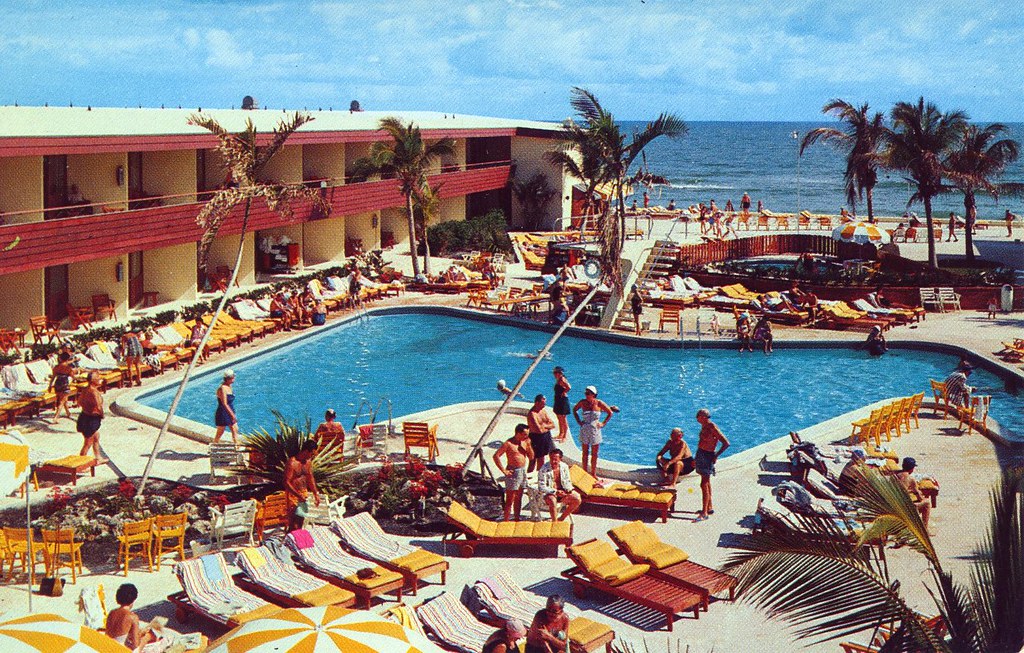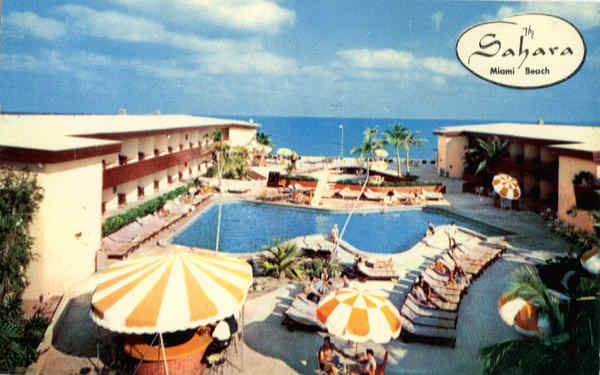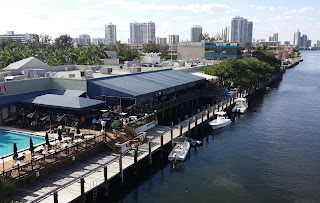
Vector in Maule Lake, with the skyscrapers of Sunny Isles Beach in the background.
I'll get to that later in the post, along with some photos and tales of what we've been up to. And, of course, no blog post from me would be complete without a couple of boat project updates. But first I want to take a little trip down memory lane, the reason for our stop here in the first place.
One of my earliest and fondest memories of my childhood was a visit here. I was perhaps eight, and I was with my dad, and his friend and business partner, who was also my godfather and whom I called "uncle," though there was no blood relation. As far as I can remember, it was my first ever airplane flight (on maybe a 707?) and I remember it as a trip "to Fort Lauderdale," even though we are halfway to Miami here, probably because that's which airport we used.

Vintage postcard showing the Florida Riviera. Our motel is about mid-photo or so.
As an adult I've been to Fort Lauderdale a couple of dozen times, and Miami perhaps half that many, and yet nothing about any visit felt familiar from that time long ago. I remembered we had stayed on the beach, at a resort called the Sahara, and a couple of years ago on an extended visit in Fort Lauderdale I was motivated to see if I could find the actual spot. I have some vivid memories of the hotel, and when I looked the place up, I was quite surprised to learn that the buildings were still there, and also that it was closer to Miami Beach than Fort Lauderdale.

The Sahara and Thunderbird today, at left, with new high-rises to the north.
High-rise development had not yet begun then on the barrier islands, and this stretch of beach was developed end-to-end in the 50s with one- and two-story motor courts, mostly U-shaped with a pool in the center and views of the ocean. The area was known as the Sunny Isles and also the Florida Riviera. Although in unincorporated Dade County, it billed itself as "Miami Beach," it's swankier neighbor just across the Haulover bridge to the south.

The Sahara in its glory days, perhaps a few years before our visit. The pool is just as I remember it.
The Sahara was one of dozens of these motels lining the beach, and several across the street on the "bay" side of the island, with names like Thunderbird, Dunes, and Castaways. The vast majority of them have been razed in the last two decades to make way for luxury high-rise condominium towers; just south of the Sahara are three enormous towers bearing the Trump moniker (it seems we can hardly anchor anyplace out of sight of a Trump Tower).

The view south from the Sahara today; at far right is the Trump complex.
A small handful of the old motor courts hang on, a pale shadow of their former selves. The Sahara is now a dilapidated condominium complex; the Thunderbird immediately north of it is now a Days Inn. The strip incorporated in 1997 as Sunny Isles Beach and now sports the modern amenities of a resort-living community well-funded by upscale developers.

Another vintage postcard.
I don't remember how long we stayed. Maybe a week? I do remember spending some time every day in the pool. I already knew how to swim, but I remember learning to "dive" into the pool here. Other than the disappearance of the high diving board, the pool is exactly the same today as it was some 45-odd years ago. The smaller "kiddy pool" closer to the beach has been filled in with concrete, and the pool now has a separate fence around it in compliance with newer codes.

The Sahara pool area from the beach. Just the same as it was, more or less.

Our room was in here, about center-frame.
I only vaguely remember the camels and Bedouins out front; they're still here, albeit with less elaborate paint, and moved a short distance to accommodate parking. What used to be a dining room is now a real estate office, and the old lobby is an underused common area. The place looks more or less exactly as we left it nearly five decades ago. The condo residents appear to be mostly octogenarian Cubanos, and the level of maintenance tells me that it won't be long until this property and the two older adjacent lots give way to yet another quarter-billion-dollar high rise complex.

The famous camels. I'm not sure why the condo kept them.

The camels in better days. Steps between them let you sit on the closer one.

The "lobby, as best I could see through the locked doors.

My dad and I at dinner.
In those days, dinner was a jacket-and-tie affair even here on the beach, and I remember going out a couple of times. I'm pretty certain this photo of my dad and me (with hair! and a smaller nose!) was taken at one of those dinners. Absolutely everyone smoked at dinner back then -- you can see someone holding a cigarette in the background. I don't remember where this was, but it might even have been right next door at the Thunderbird, which still today sports a bar, dining room, and live entertainment.

The interior of the Thunderbird.

The Thunderbird, from its courtyard pool area.
I'm glad I got to see the place one more time, before development or maybe mother nature claims it. To get to the beach side of the property I had to walk past the Trump complex, a stark contrast. We returned to Sunny Isles Beach later in the week to pick up a prescription at the CVS, and stayed for dinner at one of our favorites, a kosher (really) Mexican joint in a strip mall. The town is a real melting pot, and is sometimes known as Little Moscow for its large population of emigrant Russian Jews, many Orthodox. We'd encountered this restaurant on previous drives up the beach-side highway.

The Margaritaville Resort in Hollywood Beach, opened since our last visit, when I snapped it under construction.

Sunset over South Lake, Hollywood.
Getting back to our usual goings-on, we left Hollywood shortly after my last post here, after a final pleasant evening on the lovely Broadwalk. We had a very pleasant cruise of just an hour and a half or so to get to Sunny Isles, although we did have to station-keep in Hollywood for a bit to get the bridge timing right.

Our lone neighbor in South Lake, Hollywood, an old steel ketch, Thunderbird 5, with a storied past as Sir Martin II.

Heading out to the ICW from South Lake.
We had our sights set on a small bay just across the street from the Sahara, but shortly after turning off the ICW we promptly ran aground. Not that there is any good way ashore there anyhow. The chart said it was 7', and we had a half foot of tide when we hit the sand, so the chart is off by a foot and a half now. I was ahead dead slow and bumping in and out of gear at the time, so we were easily able to back off just with engine power. I backed all the way to the ICW and we came here instead.
Given that the lake is enormous and could easily accommodate hundreds of anchored boats, we were surprised to find ourselves the only cruising boat in the lake. A handful of boats on moorings or at anchor are clearly "parked" here, but no one is aboard. Over the course of five nights we've occasionally had perhaps one other cruiser in the lake. It's a bit off the ICW, requiring a short trip down the narrow Ojus canal, but many anchorages are at least this far.

Sunset over Maule Lake and the new Marina Palms complex behind Vector.
The legality of that is questionable; once the lake was connected to the ICW it became navigable waterway and it is now lined with houses, condos, and marinas, all of which have docks and boats that need access via the lake. A year or so ago a developer finally came up with a plan for the lake, involving 29 floating mansions; after public outcry from recreational users, the city of North Miami Beach re-zoned the lake as water (as opposed to land) and designated it as a conservation zone, thus denying the developer a permit and nixing the sale.
We've been undisturbed for our entire stay, and clearly some number of boats are permanently moored here. Also there are no restrictive signs on the way in to the lake from the ICW. We later found such a sign on the smaller entrance from the Oleta River, attached to the low bridge we ducked under in the dinghy.

This sign is only visible if you approach the lake from the Oleta, accessible only to the smallest of craft.
The Oleta wends its way back to the ICW through the mangroves of Oleta River State Park, navigable by boats of perhaps 18" draft and 3' clearance. At some points in the river all you can see are mangroves, and you can convince yourself you are miles from the heavily developed Miami Beach area. A small dock in the park affords dinghy access to shore, and the historic Blue Marlin Smokehouse fish restaurant in the park. A short walk from this dock can be found gas, sundries, food, and access to the extensive Miami-Dade transportation system. I got myself to the Sahara by boarding a bus here, and a different bus took me to Home Depot and later West Marine, making the lake quite a convenient stop.
As if access to all the above was not enough to make this a fantastic place to spend a few days, a somewhat longer dinghy ride either back out the Ojus Canal or else all the way down the Oleta, leads to a large dock on the ICW belonging to the Intracoastal Mall shopping center. This dock, free for day use and large enough even to accommodate Vector, is lined with several restaurants with dockside seating, and we sampled Duffy's (which also has a pool for guest use) and Lique Miami, both dockside, as well as Portobello's in the landlocked part of the mall. We purchased groceries at the Winn-Dixie, got massages, and shopped the dollar store and Old Navy during the course of our stay, stopping at this dock almost daily.

The free dock and "restaurant row" at the Intracoastal Mall. That's the pool at Duffy's to the left; our dinghy, Scalar, is a mere dot just to the right of center. Taken from the Sunny Isles bascule bridge as we walked across to the barrier island.
While we were here I got a few projects done, and with easy access (by bus) to Home Depot I was able to get the last of the needed parts for a long-standing project on the flybridge, to wit, adding a proper fill for the steering reservoir.

The hard-to-access steering reservoir, with a pipe plug in the fill fitting.
I'll spare you the technical discussion, but suffice it to say a hydraulic steering system like ours needs a fluid reservoir that is at the highest point in the system, in our case just a bit higher than the flybridge helm. Unsurprisingly, the reservoir is located in the helm console, just below the instrument panel, where it is above the helm pump by a couple of inches. Like many "finish" items toward the tail end of the build, this system got wrapped up in a somewhat less than professional manner. They stuck a 3/4" pipe plug in the upper reservoir fitting as a filler cap, and left the compass "loose" (unbolted) in its mount, with the idea being that you'd just pull the compass out of the console to access the fill.

Another view, showing the compass out of its mount.
There's lot of reasons not to have precision instruments rattling loose in their mounts. And filling the reservoir (fortunately not done frequently; we've only had to top it up once in three years) in this arrangement still requires some kind of flexible hose attached to a funnel, and a close eye on the level gauge. I've been meaning to address this for a while, and recently having to top up the fluid pushed me over the edge.

New fill system, involving a barb fitting and a hose to a more accessible spot.

The rest of the hose and the new fill fitting.
I replaced the pipe plug with a 90° barb fitting, ran a 3/4" vinyl hose over to an empty spot on the console, and then added a fitting with a garden-hose thread and a gasketed cap. I can now fill the reservoir without removing the compass, although I still need to stick my head behind the console (through a locker door) to read the level gauge. I don't have the right size bolts handy (and neither did Home Depot) but I will be bolting the compass into the console as soon as I can get some.

Unscrewing the "hose" cap reveals a large fill port.

Completed fill with the console back together and the compass back in place.
I also managed to source a complete replacement for my ailing computer, a used unit with a trackpad problem, and had it delivered to General Delivery in Miami Beach. Louise had our US Mail forwarded to the same address, and as of this morning it looks like it's all there. So in a short while we will weigh anchor and head south to a familiar anchorage off Miami Beach, where we know we can get ashore at perhaps the last remaining legal dinghy dock. We'll probably remain there until sea conditions are favorable for the outside run to the Keys.
Hate to see you actually bolt down that compass. I always thought it was an easy way to steer and change course simply by rotating the compass.
ReplyDelete